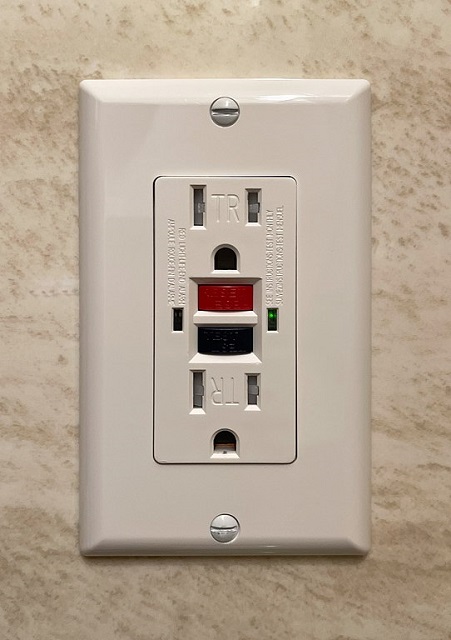Usually, we use electricity without even thinking while at home or elsewhere. But, sometimes, we can find the light not turning on or our laptop not charging even though we have plugged it in. Mostly, you can see the GFCI outlet not working. Have you thought about what you will do when the GFCI outlet won’t reset?
What is GFCI Outlet?
Ground fault circuit interrupter, GFCI in short, is a great tool that protects us from nasty electrical shocks. It helps to sense any leaks into the electrical current. If it finds any leak, it will shut the circuit down before having an accident.
But if these stop working, it is hard to understand the issue. If the breaker trips, ensure that you have to reset it to restore the electrical current to the outlet. But if the breaker doesn’t reset, it may indicate a more resounding problem.
How to fix GFCI Outlet Won’t Reset Issue:
If the problem exists, you should test it to know what is happening. You should know that when it does not work, the reasons can be moisture or dust, bad electrical connections, etc. Sometimes, something more harmful may be the reason also. There are some things that you can try to identify the issue. However, if necessary, you can always call an expert electrician.
1) Check if other GFCI Outlets in the room are working:
If you face the issue, it can cause problems with other outlets around the room. The reason is that many outlets might have a single circuit connection. In this case, you should know how the internal wiring is laid out in a home. Thus, you can learn how to pinpoint the issue. You can determine if the problem is Ground fault circuit interrupter related or something else which a professional needs to address.
You may try to test a plug-in appliance. It allows you to check if the problem remains in one or many of them throughout the room. If you find them only affected in one room, it can cause the error. Therefore, ensure to test many appliances to assure yourself that the issue is with the Ground fault circuit interrupter, not the appliance itself.
Test It Again:
If you are willing, try to toggle the test and reset buttons. Every outlet comes with a Test and Reset button; you can find these labeled black for the test button and red for reset. With the help of these buttons, you can test the power running via the Ground fault circuit interrupter. After that, you should reset the outlets.
To test the Ground fault circuit interrupter accurately, you should disconnect all devices sharing a similar circuit. After that, your job is to hit the reset button on the Ground Fault Circuit Interrupter outlet. When you hear a click after pressing the button, you need to connect the devices because the outlet must work again.
But if you find these tripping continuously after it’s been reset, the culprit may be other devices connected with it around the room. Sometimes, other appliances can overload it. If you want to test how many devices are connected, you can use an elimination process. Thus, you can know which one is creating problems. In this case, you need to connect one device at a time until it trips again.
2) Use a Circuit Tester:
In new homes, people use updated GFCI outlets with a self-testing feature. Hence, the green LED indicator shows if an outlet works appropriately or is faulty. Besides, red LED indicators let you know you need to replace them.
Multiple people can install older models, which they must manually test. Fortunately, testing outlets is an inexpensive task with life-saving advantages.
To test these manually, you should use a circuit breaker finder. It lets you know whether an outlet is receiving any power or it’s dead. If it notifies you as dead, you may need to replace it. You can use circuit breaker finders to read and display how strong each outlet’s electrical current receives. In addition, the circuit breaker helps you to determine if an outlet is working correctly. Hence, you can test all the outlets nearby to know if one of them is affected or the whole room’s power is being affected.
3) Look for Any Tripped Breakers:
Sometimes, you can find a breaker tripped, or a fuse has blown. In this case, you should go to the main electrical panel and check to see if a blown fuse causes the problem. If it happens, you should exchange the fuse and reset the Ground fault circuit interrupter. Otherwise, you should see if the breaker for the corresponding room has tripped.
If you want to know which one is causing the problem, watch the buttons inside the breaker box. You should flip the breaker switch to “off” or “on. If a switch is available in the middle position, it indicates that it has tripped and you have to reset it. Hence, your first task is to flip it to the “off” position. After that, switch it to the “on” position. Remember to reset it also. Whether you find the breaker tripping after the fix, a short circuit can cause the issue. If it is, then you must address it quickly by a licensed specialist.
4) Check if There is Any Moisture:
When you see moisture, you should try drying it thoroughly with a hair dryer connected with another outlet. If any moisture exists in or near the outlet, it will trip to stop electrocution. As soon as it trips, it will shut off and prevent electricity as a safety measure. Therefore, you need to remove all traces of moisture when it is in the outlet. Ensure that you do this before resetting the Ground fault circuit interrupter and attempting to plug anything into it.
You should connect a hairdryer to a different outlet to remove moisture. Attach the hairdryer to the Ground Fault Circuit Interrupter outlet where the moisture is present. Hence, you should use the hairdryer thoroughly to remove the moisture from the area before continuing. The reason is that if any part of moisture remains, the process becomes unsuccessful. When you dry it thoroughly, hit the reset button. After that, hear the clicking noise indicating that it has been reset and power restored.
5) Check for Bad Electrical Connections:
Ensure to power off the breaker connected to the outlet before you check any electrical connection in the wiring. Next, check two times to ensure the breaker has been flipped to the “off” position. After that, your job is to unscrew the faceplate from the outlet. Next, you should remove the screws used to hold it in the wall. Then, you can pull it out of the wall to access it easily.
You should tug on each wire gently when you expose the cables. Thus, you can ensure that these are fastened underneath the screws securely. If you don’t fasten a wire, you need to cut it. Then, you should try to connect it securely underneath the screw to ensure it is connected. According to the rule of thumb, you should connect black wires to gold screws and white ones to silver screws. Finally, use the screw securely to fasten each wire on the side of the outlet.
6) Call an Electrician:
If you have a faulty outlet, it can cause a major issue. You should address the problem by taking help from a professional who knows the issue better. If you are not experienced, you must not try to perform extensive electrical repairs yourself. It can pose a severe risk of injury like electrocution. In addition, it can pose an increased risk of property damage.
You should call a licensed electrician if you find the problem more invasive than a quick DIY repair. Ask them to look at them and check if there is any problem. Sometimes, licensed professionals ask for $50 to $100 per hour or around $300 per project, but it relies on the location. They come with specialized, high-tech equipment which can identify issues. For example, professionals can quickly determine why a GFCI outlet won’t work. They can pinpoint the problem and repair extra electrical matters.
7) Check for Incorrectly Installed GFCI Outlet:
If you have installed it wrongly, you can experience the problem. The GFCI receptacles were very costly during the 1980s compared to the current rates. In addition, builders can place only one GFCI receptacle in the home to secure all downstream receptacles, and multiple receptacles come with inefficient, wrong wiring.
Do you live in an old home? If yes, it can be installed incorrectly. Fortunately, you can reinstall the proper one easily.
- First, you should switch off the power to the circuit breaker or fuse.
- Use a voltage tester to verify the power is off. In addition, you must wear rubber shoes and use tools with rubber handles while working with anything electrical.
- After that, your job is to remove existing outlets.
- Then, unplug cables from the existing ones.
- Remove insulation to allow to display of 3/4-inch of the copper conductor.
- Next, you should detect line wires and attach new cables.
- Now, place the interrupter into the wall box.
- Finally, your job is to cover it with the wall plate.
8) Check Wire Connectors for Loose Wires:
- First, you should tug cables at Connectors.
- Then, your job is to grab the cable connector.
- Next, tug on every cable in the bundle to check for any loose cables.
- Whether you find a loose cable, you should remove the wire connector.
- Cut the cables and strip these to expose 1/2 in. to 3/4 in. of fresh copper wire. Hence, it is better to read instructions on the wire connector container to know the exact stripping length.
- If you have not found any loose connections in this box, you should expand the search to others in the vicinity.
- You can start with marked ones earlier with masking tape.
- Ensure to switch off the main circuit breaker while checking for loose connections.
9) Reinstall the Connector:
- Collect the cables to line up their ends and twist on a new wire connector.
- After that, you should twist it clockwise.
- Now, match the connector to the number of wires. Hence, you should read the label on the wire connector packaging.
- Power on the main circuit breaker again.
- Finally, you should test these again to check if the issue is fixed.
Conclusion:
Ground fault circuit interrupter can sense any leak into electrical current. So when a GFCI outlet won’t reset, we recommend you go through our solutions.
Frequently Asked Questions:
- What happens when a GFCI outlet won’t reset?
If you find the button not popping out while hitting the “test” button, ensure that no power exists, or you may contain a poor interrupter. When the “reset” button trips again each time tapping, a dangerous current leak may exist somewhere on the circuit.
- What do you do when your outlet won’t reset?
These are the things you can try—
- Check it to find if the other outlets are dead.
- Check for the tripped circuit or a blown fuse.
- Check the interrupter.
- Find loose or bad connections.
- Reinstall the connector.
- How do you know if a GFCI outlet is bad?
If an interrupter trips, it will not supply power. As a result, your hair dryer or power saw will not work. Also, whether a tripped interrupter is at the beginning of a circuit, it might cut power to the whole circuit. Therefore, other lights on the circuit will not work.







